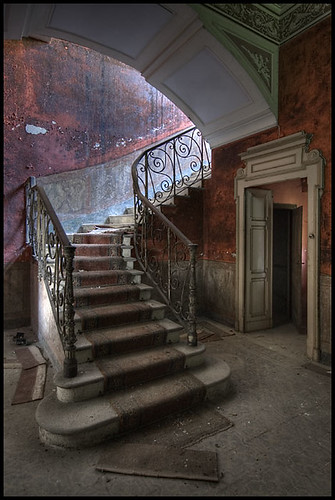Monday, April 28, 2008
Jeremiah the Second
I love hearing these pundits wag their fingers at Rev. Wright's wood-work shattering "Hi America!" tour. I guess he's now the poo in Obama's shoe. Whatever...He can't be more right about the confusion of criticism with anti-patriotism. Which antics are worse, the droll bombast of a preacher or the antics of cowardice, hubris & denial? Kinda brings me back to the antics of denial practiced by some really, really old pundits, when they asked Jeremiah I,
"Why have you prophesied in the name of the LORD, saying, 'This house shall be like Shiloh, and this city shall be desolate, without an inhabitant'?" And all the people were gathered against Jeremiah in the house of the LORD. When the princes of Judah heard these things, they came up from the king's house to the house of the LORD and sat down in the entry of the New Gate of the LORD's [house.] And the priests and the prophets spoke to the princes and all the people, saying, "This man deserves to die! For he has prophesied against this city, as you have heard with your ears" (Jeremiah 26:9-11)
Sunday, April 27, 2008
What can leaves do?

Thursday, April 17, 2008
No, no, no, no!

Paul Lukez (also mentioned) was one of the architecture profs at MIT...although I never took his studio.
Monday, April 7, 2008
#13b: When Flow Exceeds Form
In more than one occasion a friend of mine (knowing I'm a planner - as if I can do something about it, ha!) has lamented the fact that Charlotte's greenways are paltry amenities compared to the river life that abounds in places like Greenville and Charleston...Some have even suggested we build an artificial canal like San Antonio to aid our soporific Uptown nightlife. (To which I respond: We do have a river! We just allowed McMansion developments to cut us off from it.)
Matt Edgeworth not only elucidates why rivers tickle our urbanist fancy, he evocatively suggests a whole framework for understanding humankind's technological genesis:
...rivers were the first artifacts. The great human transformation of the material domain may have started with things that were fluid rather than the fixed. From the moment that hominids placed stones across a stream to step across to the other side, or built a crude dam in order to create a pool for fishing or bathing, they were starting to influence and control the flow of water…
Rivers taught us to urbanize, to become technological beings, but there is something downright holy about rivers...Just ask John the Baptist. We were implanted with great reason at the Edenic confluence of four great rivers. Religious activity is a processive art...an encounter with the flow-artifacts of life. To bring the spiritual to the mundane requires an understanding of life-cycles, seasons, phases and cultural pacts, the temporal phenomena of interchange, and our relationships to other beings.
Ann Galloway elicits the multi-disciplinary implication of Edgeworth's archaeological insights:
I may be biased by my previous life as an archaeologist, but I still don’t know any other disciplinary perspective that so persistently and convincingly troubles stable categories like nature and culture, and I think that Edgeworth’s essay is particularly evocative in its assessment of flow and the capacity to exceed form.
Besides mobile technologies, what other areas of study or practice could benefit from such an approach?
My answer: urbanism...or at least the form-fixated urbanism of the new urbanists.
Saturday, April 5, 2008
#13: What the "new urbanism" can't quite get
The recalcitrant David Harvey puts it best: Towards economic, social and even to some extent environmental sustainability, the practicioners of the new urbanism have been mostly all talk...and, indeed, lazy thinkers fixated on form. It seems the CNU folks are dedicated to preserving the suburban trope of their work: creating white enclaves on greenfields. As Sam Newburg reports at their current convention in Austin, they are indeed pouting over the fact that their suburban developments won't qualify for LEED-ND.
I always thought the "transect" was a stultifying model for describing the complexities of sustainable urbanism, which beggar questions about economic and social networks and the kind of things cities actually depend on for their existance...but now I've come to realize that the "transect" is an apt description of the mental lobotomy going on in the brain of a New Urbanist with respect to regional and global thinking. The only transects we need in the local context are the mass transit kind. New urbanists should talk instead about networks...sustainable processes. I'm still waiting for them to begin to develop what David Harvey calls a "utopia of process".
My single challenge to a new urbanist: What can you do for Dharavi?
Tuesday, April 1, 2008
Urbexing
In an undignified surprise, I discovered that my peculiar disease for exploring decaying urban sites is actually shared by an entire subculture of folks called "urbexers". Of course, my explorations tend to be a meditative excursion to try to train my eyes to notice the overlooked spaces that folks actually DO look at every day...For example, the way a billboard makes the building below it peacefully and blissfully nonplussed in its surreal and lonely beauty.
Not related: The photo above actually reminds me of a season I spent in the decaying and gothic Hotel Imperial in the Old City of Jerusalem. Warm shards of dusty light suddenly flood my memory stairwells.




